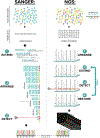A Clinician's Guide to Bioinformatics for Next-Generation Sequencing
- PMID: 36379355
- PMCID: PMC9870988
- DOI: 10.1016/j.jtho.2022.11.006
A Clinician's Guide to Bioinformatics for Next-Generation Sequencing
Abstract
Next-generation sequencing (NGS) technologies are high-throughput methods for DNA sequencing and have become a widely adopted tool in cancer research. The sheer amount and variety of data generated by NGS assays require sophisticated computational methods and bioinformatics expertise. In this review, we provide background details of NGS technology and basic bioinformatics concepts for the clinician investigator interested in cancer research applications, with a focus on DNA-based approaches. We introduce the general principles of presequencing library preparation, postsequencing alignment, and variant calling. We also highlight the common variant annotations and NGS applications for other molecular data types. Finally, we briefly discuss the revealed utility of NGS methods in NSCLC research and study design considerations for research studies that aim to leverage NGS technologies for clinical care.
Keywords: Bioinformatics; DNA; Next-generation sequencing; Review.
Copyright © 2022 International Association for the Study of Lung Cancer. Published by Elsevier Inc. All rights reserved.
Figures




References
-
- Sanger F, Air GM, Barrell BG, et al. Nucleotide sequence of bacteriophage phi X174 DNA. Nature. 1977;265(5596):687–695. - PubMed
-
- Shendure J, Porreca GJ, Reppas NB, et al. Accurate multiplex polony sequencing of an evolved bacterial genome. Science. 2005;309(5741):1728–1732. - PubMed
-
- Austin MC, Smith C, Pritchard CC, Tait JF. DNA Yield From Tissue Samples in Surgical Pathology and Minimum Tissue Requirements for Molecular Testing. Arch Pathol Lab Med. 2016;140(2):130–133. - PubMed
Publication types
MeSH terms
Substances
Grants and funding
LinkOut - more resources
Full Text Sources
Medical

